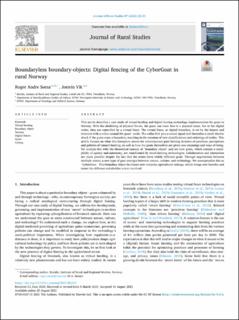| dc.contributor.author | Søraa, Roger Andre | |
| dc.contributor.author | Vik, Jostein | |
| dc.date.accessioned | 2022-02-21T09:35:01Z | |
| dc.date.available | 2022-02-21T09:35:01Z | |
| dc.date.created | 2021-08-28T22:53:12Z | |
| dc.date.issued | 2021 | |
| dc.identifier.citation | Journal of Rural Studies. 2021, 87 23-31. | |
| dc.identifier.issn | 0743-0167 | |
| dc.identifier.uri | https://hdl.handle.net/11250/2980405 | |
| dc.description.abstract | This article describes a case study of virtual herding and digital fencing technology implementation for goats in Norway. With the abolishing of physical fences, the goats can roam free in a physical sense, but in the digital realm, they are controlled by a virtual fence. The virtual fence, or digital boundary, is set by the famers and interacts with a collar around the goats’ necks. The collar first give a sound signal and thereafter a small electric shock if the goats cross a boundary, resulting in the creation of new classifications and orderings of reality. This article focuses on what this disruption means for contemporary goat farming in terms of practices, perceptions and policies of (smart) farming, as well as how the goats themselves are given new meanings and ways of being. We analyze this with the theoretical concept of “boundary object” and see how goats, which contain a multiplicity of agency and autonomy, are transformed by smart-farming technologies. Collaboration and interaction are made possible despite the fact that the actors have widely different goals. Through negotiations between multiple actors, a new type of goat emerges between nature-, culture- and technology. We conceptualize this as “CyborGoat.” This boundary object facilitates new everyday agricultural settings, which brings new benefits and issues for different stakeholder actors involved. | |
| dc.language.iso | eng | |
| dc.relation.uri | https://www.sciencedirect.com/science/article/pii/S0743016721002394 | |
| dc.title | Boundaryless boundary-objects: Digital fencing of the CyborGoat in rural Norway | |
| dc.type | Peer reviewed | |
| dc.type | Journal article | |
| dc.description.version | publishedVersion | |
| dc.subject.nsi | VDP::Teknologi: 500 | |
| dc.subject.nsi | VDP::Technology: 500 | |
| dc.subject.nsi | VDP::Teknologi: 500 | |
| dc.subject.nsi | VDP::Technology: 500 | |
| dc.source.pagenumber | 23-31 | |
| dc.source.volume | 87 | |
| dc.source.journal | Journal of Rural Studies | |
| dc.identifier.doi | 10.1016/j.jrurstud.2021.08.015 | |
| dc.identifier.cristin | 1929497 | |
| dc.relation.project | Forskningsmidlene for jordbruk og matindustri: 280554 | |
| dc.relation.project | Norges forskningsråd: 280554 | |
| cristin.ispublished | true | |
| cristin.fulltext | original | |
| cristin.qualitycode | 2 | |
